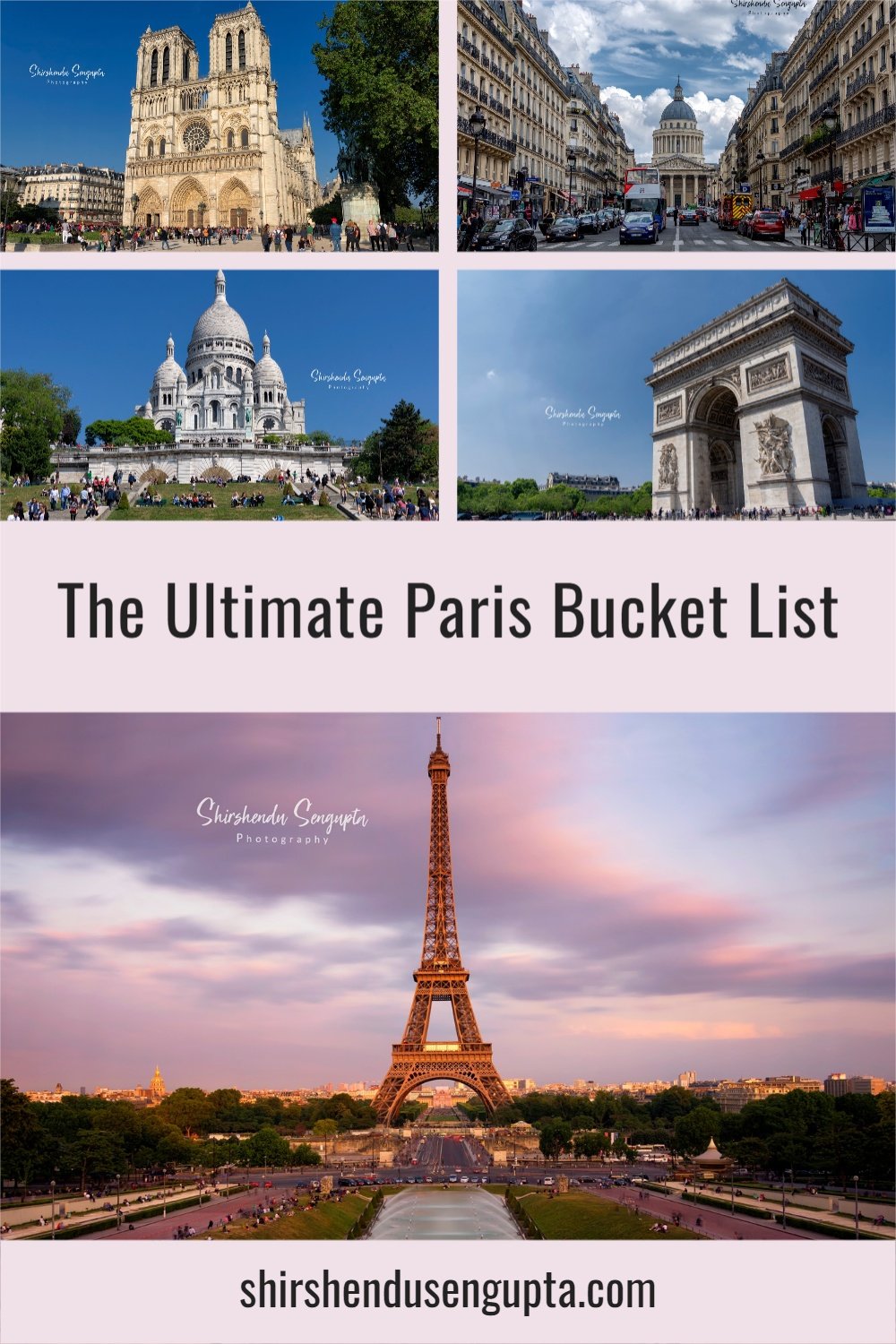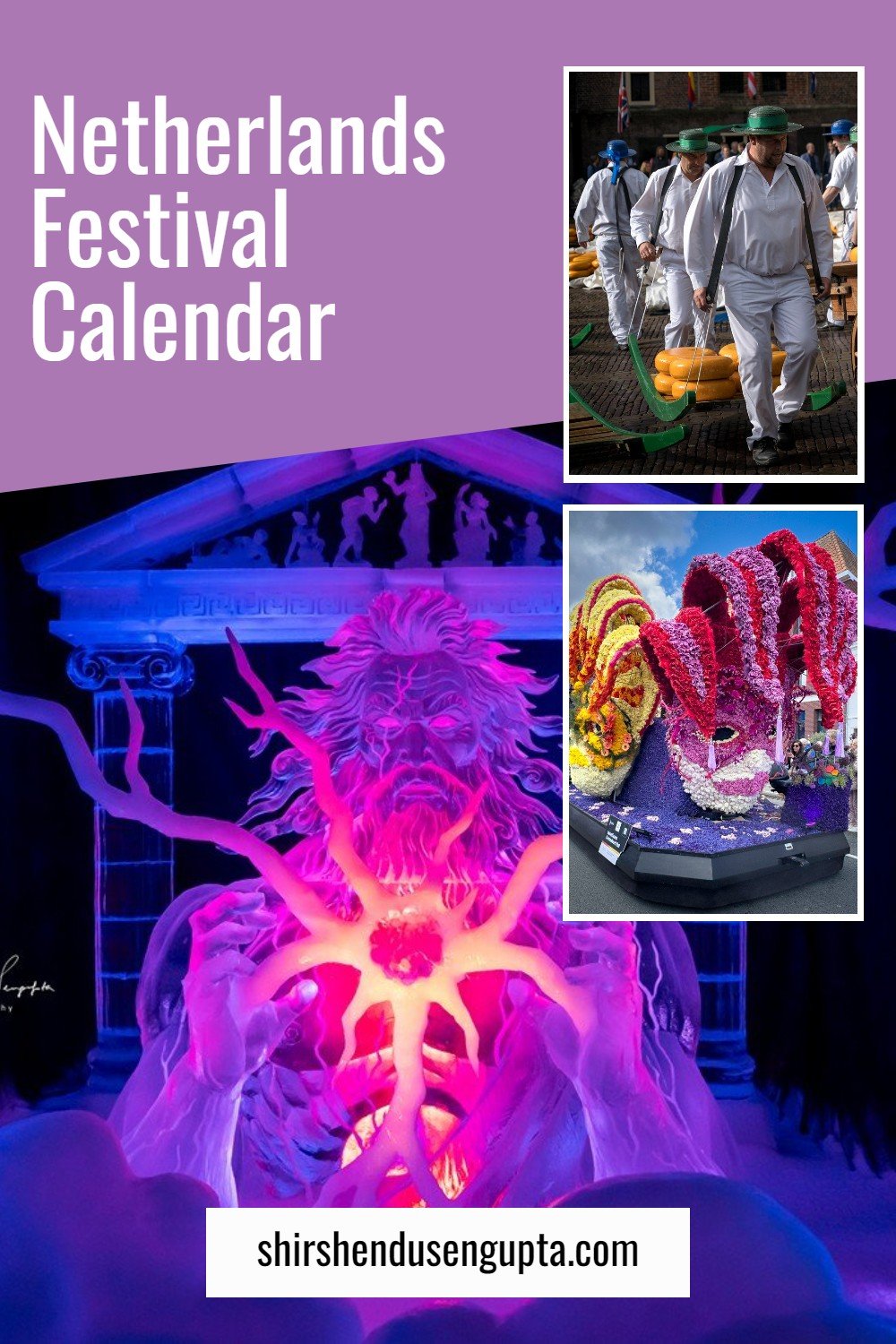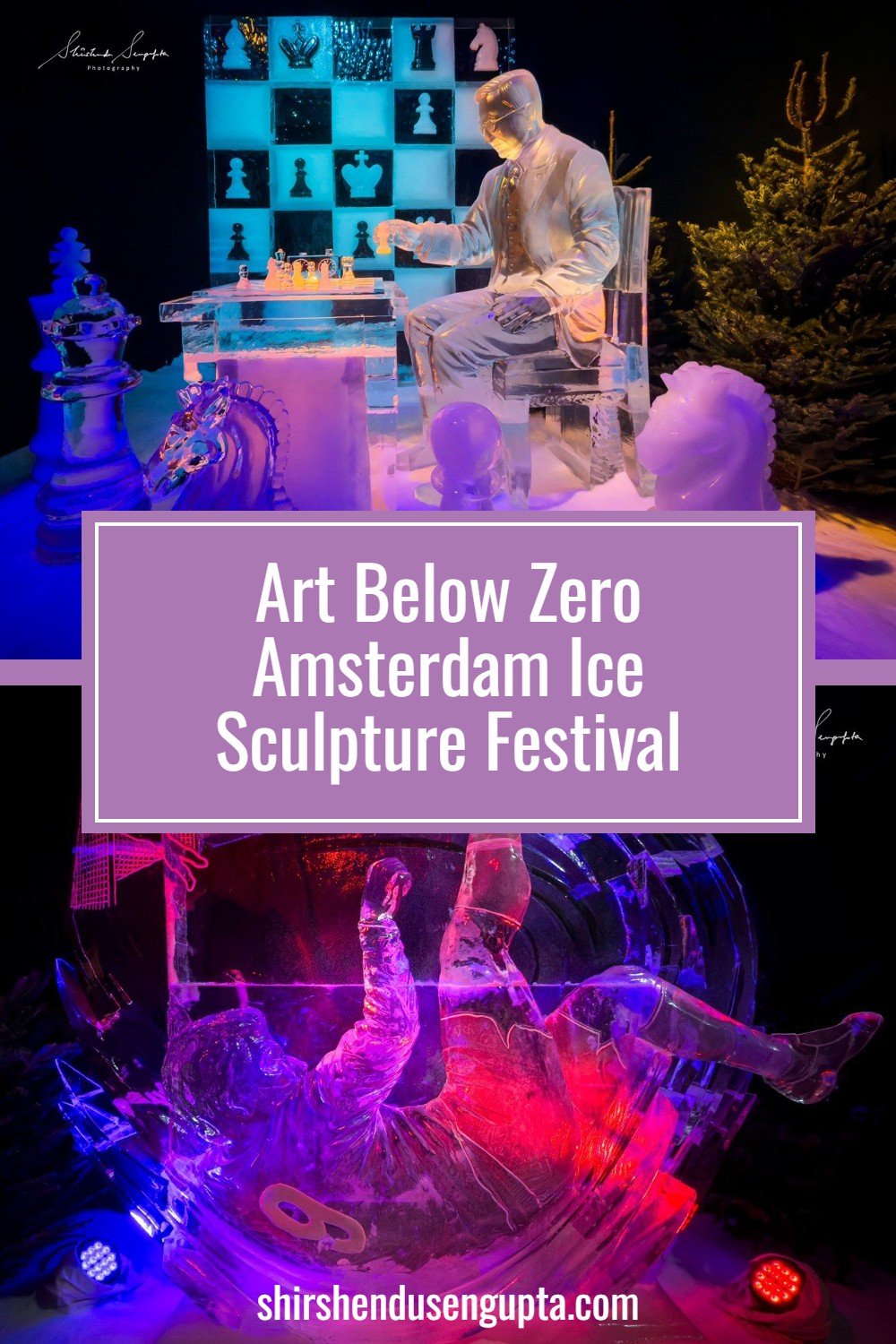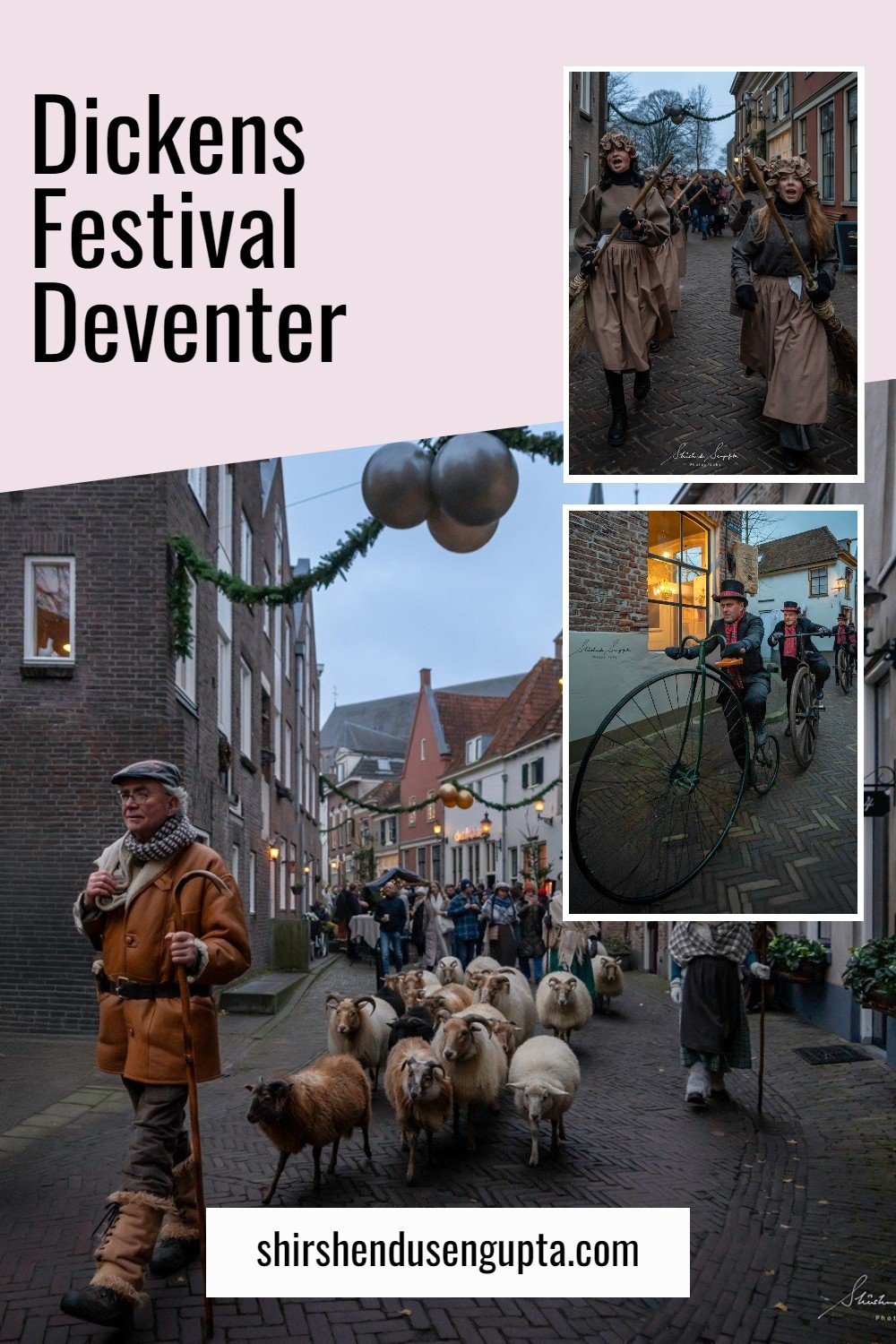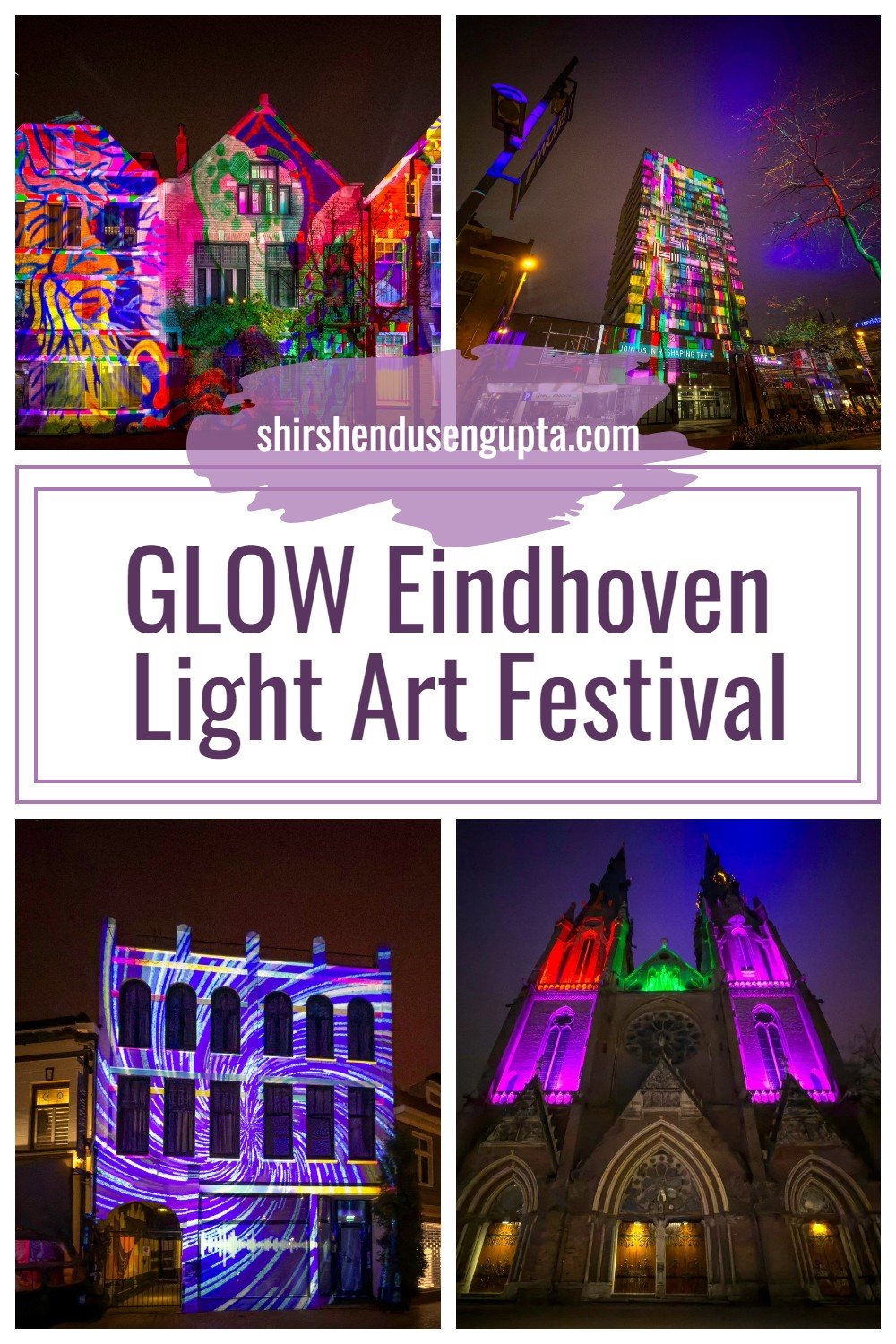The Ultimate Paris Bucket List | 13 Best Places to Visit in Paris | 13 Must See Tourist Attractions in Paris | Top 13 Things to See and Do in Paris over a Weekend Getaway
Welcome to Paris - The City of Lights
With the sky-kissing wrought-iron Eiffel Tower, the monumental Arc de Triomphe guarding the opulent avenue des Champs-Élysées, the iconic Notre Dame cathedral, lamplit bridges across the Seine, and the wicker-chair-lined terraces of art nouveau cafes, Paris is a beacon of art, architecture, and fashion on the face of our planet. Lutece, Paname, Pentruche, City of Lights, City of Love - known by different names to different people, it has witnessed the creations of masters like Renoir, Rodin, Picasso, Monet, Manet, Dali, and Van Gogh and has housed treasures since antiquity. Today I’m going to take you along with me on a ride across the 13 best places to visit in Paris that can be done over the weekend. Let the journey begin!
13 Best Places to Visit in Paris
1. Eiffel Tower
The Eiffel Tower, known in French as La Tour Eiffel, was the centerpiece of the 1889 Paris Universal Exposition (Exposition Universelle) also known as the World’s Fair. It was built to mark the French Revolution's centennial and to showcase France's industrial superiority to the rest of the globe. The tower that bears his name is commonly credited to Gustave Eiffel, a French civil engineer. The initial blueprints for the monument were created by two lesser-known men, Maurice Koechlin and Emile Nouguier, principal engineers for Gustave Eiffel's engineering firm, the Compagnie des Etablissements Eiffel. The engineers, along with Eiffel and a French architect named Stephen Sauvestre, entered a competition to decide the centerpiece for the 1889 World's Fair in Paris. The Eiffel company's design was chosen, and the wrought-iron tower was completed in July 1887.
However, not everyone in Paris was enthusiastic about the prospect of a massive metal monument looming over the city. Before the Eiffel Tower, modern architecture was beginning to emerge in Paris. But it did so in a rather shy manner. Because of the Industrial Revolution, iron became a prominent building material, and it became a cornerstone of contemporary architecture. However, by 1887, it had only been seen on the inside, as support structures, or in minor structures such as hothouses, factories, and bridges. When work on the Champs de Mars tower began, a group of 300 artists, sculptors, writers, and architects petitioned the Paris Exposition commissioner to halt building of the "ridiculous tower" that would dominate Paris like a "gigantic black smokestack." The artistic community's objections, however, fell on deaf ears. On March 31, 1889, the tower's construction was finished in slightly over two years. Eiffel was given a 20-year permit to keep the tower standing. It was scheduled to be demolished in 1909, with ownership reverting to the City of Paris. The City had intended to demolish it (one of the initial contest requirements for building a tower was that it should be simple to remove), but because the tower proved to be useful for communication, it was permitted to stay after the permission expired. Eiffel used his residence at the top of the tower to conduct meteorological observations and to conduct tests on the effects of air resistance on falling bodies. Each of the 18,000 parts used to construct the tower was calculated and prepared in Eiffel's factory on the outskirts of Paris solely for the project.
The wrought-iron construction is made up of four massive arching legs that are supported by masonry piers that curve inward until they meet in a single, tapered tower. It took 2.5 million thermally joined rivets and 7,300 tons of iron to construct the structure. Workers painted every inch of the structure to protect it from the elements, which took 60 tons of paint. The tower is illuminated by a total of 5 billion lights.
It is now regarded as a global cultural icon of France and one of the world's most recognizable monuments. The Eiffel Tower is the world's most visited paid monument, with 6.91 million visitors in 2015. Measuring at 324 meters (1,063 feet), about the same as an 81-story skyscraper, it is the highest structure of Paris, and the second highest structure of France after the Millau Viaduct. The Eiffel Tower eclipsed the Washington Monument during construction to become the world's highest man-made structure, a title it held for 41 years until the Chrysler Building in New York City was completed in 1930. It is currently 5.2 meters (17 feet) taller than the Chrysler Building, thanks to the placement of a broadcasting aerial to the summit of the tower in 1957. Visitors can access the tower on three levels, that house two restaurants, many buffets, a banquet space, a champagne bar, and other unique gift shops. The platform of the top level is 276 meters (906 feet) above ground level, making it the highest public observation deck in the European Union.
2. Louvre Museum
Situated along the banks of the Seine River, the beautiful baroque-style castle and museum Le Musée du Louvre is the world's largest art museum and one of the Paris's most popular tourist destinations. It is home to one of history's most illustrious art collections.
The Louvre was originally built as a fortress in 1190. It was later repurposed as a royal residence in the 16th century. Louis XVI and his wife, Marie Antoinette, were forcibly dragged from Versailles and beheaded in Tuilleries Palace in Paris, which was then next to the Louvre, during the French Revolution. In August 1793, the National Assembly established the Louvre as a museum, with a collection of 537 artworks. Within a span of three years, the museum was shut down due to structural issues.
In 1801, Napoleon reopened the museum and enriched the collection, renaming it Musée Napoléon. Napolean planned to build a museum in France that would house a magnificent collection of art from all around the world. He added to it by bringing artwork from his military campaigns, private donations, and commissions. The Louvre underwent a remodeling plan known as the Grand Louvre in 1983. A new design for the main entrance was part of the proposal. The project was awarded to architect I.M. Pei, who created an underground lobby and a futuristic glass pyramid building in the courtyard. The pyramid, which was unveiled in 1988, went on to become a well-known feature of the museum's design. It exemplifies the Louvre's everlasting beauty by combining classic and modern architecture. The Inverted Pyramid, a skylight that dips into the basement foyer, was first unveiled in 1993. It has been depicted as the point of Holy Grail in Dan Brown’s novel ‘Da Vinci Code.’ The author claimed that the remains of Mary Magdalene, the character from Bible who was controversially purported as the wife of Jesus Christ in the novel, are buried underneath the inverted pyramid. As of now there’re no concrete evidences of either.
The "Mona Lisa" by Leonardo da Vinci, who enchants thousands of visitors with her mysterious smile, is without a doubt the Louvre's most famous painting. This small, iconic picture which measures only 21 by 30 inches (53 by 77 cm) is protected by bullet-proof glass and guards. This security is due to the fact that it was stolen in 1911 (it was found in 1913). The armless beauty of the "Venus de Milo" and "Winged Victory," an ancient Greek sculpture also known as "Nike of Samothrace," draw large crowds. A stele inscribed with the Code of Hammurabi, da Vinci's dramatic sculpture "The Dying Slave," and Antonio Canova's 18th-century sculpture "Psyche Revived by Cupid's Kiss" are among the most popular works. "Liberty Leading the People" by Eugene Delacroix is considered to have inspired Victor Hugo's "Les Miserables," while Jacques-Louis David's "The Coronation of Napoleon" was commissioned by Napoleon himself and serves as a reminder of the Louvre's past.
Monalisa by Leonardo da Vinci
Winged Victory or Nike of Samothrace
Aphrodite of Milos aka Venus de Milo by Alexandros of Antioch
The Dying Slave from the Captive Series by Michelangelo
3. Sacre-Coeur Basilica
The Sacre-Coeur Basilica or the Basilica of the Sacred Heart of Paris, is a Roman Catholic church and minor basilica situated atop the Butte Montmartre (Hillock of Montmartre), the highest point of Paris. Sacre-Coeur is a political and cultural double monument, serving as a national penance for France's defeat in the 1870 Franco-Prussian War and the socialist Paris Commune of 1871, which crowned the city's most rebellious neighborhood, as well as an embodiment of conservative moral order, publicly dedicated to the Sacred Heart of Jesus, which was an increasingly popular vision of a loving and sympathetic Christ at the time. Paul Abadie was the architect who designed the basilica. Construction started in 1875 and ended in 1914. The basilica was consecrated in 1919, following the end of World War I.
4. Notre-Dame Cathedral
The medieval Catholic Cathedral of Notre-Dame (literally "Our Lady of Paris"), is located on the Île de la Cité (an island on the Seine river) in the fourth arrondissement of Paris. The cathedral is widely regarded as one of the finest examples of French Gothic architecture, and it is one of the largest and most well-known religious buildings in France and the globe. Its naturalistic sculptures and tinted glass set it apart from prior Romanesque buildings. A reliquary in the cathedral treasury houses some of Catholicism's most sacred relics, such as the alleged Crown of Thorns, a sliver of the True Cross, and one of the Holy Nails.
During the radical period of the French Revolution in the 1790s, much of Notre-Dame's religious imagery was destroyed. The famous French novel Hunchback of Notre-Dame by Victor Hugo, published in 1831, that tells the story of how beautiful gypsy Esmeralda makes friends with Quasimodo, the hunchbacked bell ringer of the Notre-Dame Cathedral, inspired popular interest in the cathedral. In 1845, Eugène Viollet-le-Duc began a major repair under his supervision. In 1991, a restoration and maintenance project was launched.
The roof of Notre-Dame caught fire on April 15, 2019, while it was being renovated and restored, and it burnt for roughly 15 hours. As a result, the cathedral was severely damaged. Most of the lead-covered wooden roof above the stone vaulted ceiling, as well as the flèche (the timber spirelet over the crossing), was completely destroyed. Many restoration ideas following the fire suggested modernizing the cathedral's architecture, but the French National Assembly rejected this approach and decided to restore the cathedral's "historic, aesthetic, and architectural interest." In November 2020, the task of preventing the structure from collapsing was accomplished, and reconstruction began in 2021. On April 14, 2021, President Emmanuel Macron said that the cathedral site will be formally restored to the church on April 15, 2024, and that the first mass since the fire will be celebrated in the cathedral nave on that day, even if the rebuilding is not completed by then.
5. Arc de Triomphe
The Arc de Triomphe de l'Étoile is one of Paris' most iconic monuments, standing at the western end of the Champs-Élysées at the center of Place Charles de Gaulle, originally known as Place de l'Étoile, (the étoile or "star" of the intersection formed by its twelve radiating avenues). The names of all French victories and generals are etched on the inner and outer surfaces of the Arc de Triomphe, which honors those who fought and died for France during the French Revolutionary and Napoleonic Wars. The Tomb of the Unknown Soldier from World War I rests under its vault. It was the world's tallest triumphal arch until the Monumento a la Revolución in Mexico City, which stands 67 meters (220 feet) tall, was completed in 1938. The Pyongyang Arch of Triumph, which was finished in 1982 and is slightly taller than the Arc de Triomphe at 60 meters (197 feet), is modeled after the Arc de Triomphe.
It was built in 1806 after Emperor Napoleon's victory at Austerlitz, when he was at the height of his power. The foundations alone took two years to lay, and Napoleon had a wooden mock-up of the completed arch built when he approached Paris from the west in 1810 with his bride Archduchess Marie-Louise of Austria. After the architect, Jean Chalgrin, died in 1811, Jean-Nicolas Huyot took over the project. Work on the arch was temporarily halted when Napoleon was forced to abdicate in 1815, but the restored Bourbon king Louis XVIII opted to resume building after 1824, and it was formally inaugurated by King Louis Philippe, France's penultimate monarch.
6. Pont Alexandre III (Alexander Bridge)
The Pont Alexandre III is one of the world's most stunning river crossings and is one of Paris's most exquisite, enormous, and luxurious bridges. It was constructed for the 1900 Exposition Universelle, an international world's fair that featured talking movies, escalators, Russian nesting dolls, wireless telegraphy (radio), and the world's most powerful telescope. Rudolf Diesel demonstrated his revolutionary peanut-oil-powered combustion engine, and the city hosted the first Olympic Games held outside of Greece. The exhibition popularized the Art Nouveau style, and it was the first time electric lights were used to illuminate the City of Light. Tsar Alexander III, who sealed a Russian alliance with the Third Republic in 1892, is commemorated by the bridge. The bridge celebrates the establishment of a new diplomatic partnership between France and Russia, whose aristrocrats acquired French as fluently as their own tongue at an early age. In October 1896, Alexander's son, Nicholas II, placed the foundation stone for the bridge.
The bridge connects the Left Bank's Les Invalides, where Napoleon's mausoleum is located, with the Right Bank's Champs-Élysées. Walking across the bridge leads you to what may be considered Paris' premier open-air museum, which features a diverse collection of masterful sculptures, including lions, cherubs, nymphs, maidens, cupids, water spirits, fish, scalloped seashells, and sea monsters.
7. Grand Palais (Grand Palace)
The World's Fair took place in Paris in 1900. Because of the significance of the occasion, the city embarked on a variety of construction projects, including the Pont Alexandre III, the Grand Palais, and the smaller but identical Petit Palais. The Grand Palais, with its majestic glass-domed top, is one of Paris' most distinctive monuments. Although the project was directed by renowned French architect Charles Girault, who was later given full blanche to build the Petit Palais, it was the work of three separate architects. A classicist stone exterior, Art Nouveau ironwork, and glass combine to create a stunning structure. The Grand Palais presently holds the status of being the world's largest existing ironwork and glass edifice, a record previously held by London's Crystal Palace, which was destroyed in a fire. This mansion with a Belle Epoque pinnacle has a steel framework weighing 9,400 tons, 15,000 square meters (162,000 square feet) of glass, and 5,000 square meters (5,400 square feet) of galvanized iron/zinc roofing. The facade is built of stone and has intricately sculpted figures and gorgeous colored mosaics. Today, the Grand Palais houses the Palais de la Découverte (a science museum), the Galeries National du Grand Palais (an exposition hall), and the Nef du Grand Palais (an event hall).
8. Petit Palais (Small Palace)
The Petit (Small) Palais, like its sister across the street, the Grand Palais, was erected for the Universal Exposition in 1900 and reopened in 2005 after more than four years of restoration. Originally intended to be a temporary structure to house a great exposition of French art, this magnificent Beaux Arts-style building, designed by Charles Girault, became a favorite among Paris inhabitants, who refused to demolish it, and it still remains today. The front of Petit Palais's rather classical exterior is lined with Ionic columns. It incorporates Greek and Roman forms, as do many Beaux Arts structures, but also has a lot of ornamentation, giving it an eclectic aesthetic.
The palace is home to the Musé des Beaux-Arts (Museum of Fine Arts), which houses an exceptional collection of artwork spanning several centuries. It's been compared to a miniature Louvre, but without the crowds. Auguste Dutuit, who bequeathed the museum additional funds to buy more artwork, is responsible for the majority of the collection. There are over 12,000 prints in this museum, as well as hundreds of tapestries, sculptures, medieval items, rare manuscripts, and icons.
9. Les Invalides
Les Invalides is a complex of buildings in Paris's 7th arrondissement that houses museums and monuments relating to France's military history. The Dôme des Invalides, a gold-domed edifice presently utilized as a burial ground for a number of the country's war heroes, is the most recognizable and well-known part of Les Invalides.
Les Invalides, was proposed by Louis XIV in 1670 as a home for crippled and impoverished war veterans or "invalids.” It was designed by Libéral Bruant and finished in 1676. In the same year, King Louis XIV, the Sun King, commissioned architect Jules Hardouin Mansart to design a separate private chapel for the royal family at the Invalides. Many people are familiar with this gold-domed church, which was completed in 1708 by de Cotte after Mansart's death. This chapel, known as Église du Dôme, was inspired by Rome's St. Peter's Basilica and is considered one of the world's most enticing examples of French Baroque architecture. The dome stands 107 meters (351 feet) tall, making it one of Paris' highest monuments. It was strategically situated in the center of the complex to dominate the court of honor, one of fifteen courtyards designated for military parades. Charles de La Fosse, a follower of well-known French painter Charles Le Brun in the eighteenth century, painted the interior of the dome.
While Napolean was alive, at his suggestion, a memorial to Sébastien le Prestre de Vauban, the marshal of King Louis XIV's army, was erected here in 1808. An urn containing Vauban's ashes can be found in the monument. However, after his defeat in the War of Waterloo and subsequent exile, Napoleon Bonaparte breathed his last on the island of St. Helena and was buried there until King Louis-Philippe agreed to have his body excavated and returned to Paris in 1840, fulfilling his last wish to be buried on the banks of the Seine River. He decided to bury him at Les Invalides. To make room for the tomb, architect Louis Visconti had to rebuild the domed church's high altar. The bones of Napoleon's body were then buried in six coffins inside a tomb made of red Finnish porphyry with a green granite base and placed inside the crypt after it was completed in 1861. Around the monument, a dozen huge figures are positioned to represent Napoleon's victories. In dramatic contrast to the French commander's modest height in reality, a statue more than 8 feet tall (2.4 m) clad in coronation robes stands nearby. Several members of Napoleon's family, as well as a number of famous French military leaders and war heroes, are buried at Invalides. The bronze mausoleum of Marshal Ferdinand Foch, commander of the allied armies at the end of World War I, is another huge monument in the Dôme des Invalides.
10. Pantheon
When King Louis XV fell ill in 1744, he promised that if he lived, he would erect a church dedicated to Sainte-Geneviève. After his recovery, Louis entrusted the construction of the church to the Marquis of Marigny, which was to replace the sixth-century basilica known as the Abbey Sainte-Geneviève at the time. The Marquis commissioned Jacques-Germain Soufflot to construct a new, grand church in 1755. In 1757, work on the enormous structure began. The project took 34 years to complete, primarily owing to financial issues. After Soufflot's death in 1780, the project was handed over to his associate Guillaume Rondelet. The structure was completed in 1791, during the French Revolution. In the same year, the Revolution's Constituent Assembly decided by decree to convert the church into a temple to house the relics of France's great men. Architect Quatremère de Quincy adapted the structure to its new role as a pantheon. The edifice was converted again into a church in 1806 but has been used as a civic facility since 1885.
The astronomer Jean Bernard Léon Foucault initially held his famous experiment, establishing that the world spins about its axis, in the Panthéon in 1851. The Foucault pendulum was transported to the Conservatoire des Arts et Métiers in Paris. Due to construction at the Conservatoire, it was temporarily relocated to the Panthéon in 1995.
11. Opera National de Paris
One of the greatest opera and ballet houses in the world is the Paris Opera. Louis XIV founded it more than three centuries ago, and it has two theaters: the Opéra Bastille (1989) and the Palais Garnier (1875). With more than 350 performances annually, its goal is to protect and advance French history in ballet and opera. Here were premiere performances of works by renowned composers including Rameau, Gluck, Rossini, Verdi, Wagner, Gounod, Massenet, Poulenc, and Messiaen. With a long history, the ballet group performs all around the world. The greatest choreographers, including George Balanchine, Serge Lifar, Rudolf Nureyev, Roland Petit, Maurice Béjart, and Pina Bausch, have all performed there over the years.
12. Luxor Obelisk
An old Egyptian obelisk that was transported to France from Luxor, Egypt, on May 10, 1833, is located at the foot of the Champs Elysées, in the middle of the Place de la Conorde, one of the most famous traffic circles in the world. And it was here, on October 25, that year, that it was inaugurated in front of a cheering audience and King Louis-Philippe I. The so-called Luxor Obelisk is 22.5 meters tall, 227 tons in weight, and composed of red granite. The largest obelisks that Ramses II had built in Egypt were this one and its pair that remains in front of the temple's first pylon in Luxor.
13. Versailles Palace
Versailles is located roughly 20 kilometers outside of Paris. The town and estate were first mentioned in a charter of the Abbey of Saint-Père de Chartres in the year 1038. Versailles was a farm community with a castle and the church of Saint-Julien by the end of the eleventh century, and it remained prosperous until the thirteenth century. However, only a few people remained after the Hundred Years War.
In 1662, Louis XIV, the new monarch, took a keen interest in Versailles. Louis XIV, often known as The Sun King, despised Parisians and desired to relocate his Royal Residence away from the Louvre Palace, which was constantly roiled by political strife. The Sun King was responsible for much of the expansion that resulted in the current structure. He commissioned architect Louis Le Vau and artist Charles Le Brun to complete this Baroque masterpiece, which would go on to become the ideal model for all European palaces.
The unparalleled Versailles Garden was created by the renowned gardener André le Nôtre in the seventeenth century. The garden of the Versailles Palace is Europe's biggest palace garden, measuring 100 hectares (approximately 250 acres). Paths, bushes, flowerbeds, and trees are placed in a geometric arrangement throughout the garden. Le Nôtre also drained the swampy, sloping land, creating a succession of basins and the Grand Canal.
Visiting Paris
Best Time to Visit: The best seasons to visit Paris are spring (from April to June) and fall (from September to October) when the city is less congested and the weather is milder than in the summer. Autumn delivers stunning foliage and cultural activities, while spring brings blooming flowers and the outdoor cafe culture. Since we live in the Netherlands and hence France’s our neighbor, we’ve visited Paris a number of times mostly during late spring (May) or summer (July or August).
Number of Days to Stay: We suggest a minimum of four to five days to truly experience Paris and its attractions. You can see the famous sites, take leisurely walks along the Seine River, explore the city's diverse neighborhoods, and enjoy its culinary delights.
Best Place to Stay: The ideal location to stay in Paris depends on your tastes and budget. The Marais neighborhood's hip cafes, fashionable stores, and historic sites provide a lively atmosphere. Saint-Germain-des-Prés is renowned for its creative atmosphere and literary past, while the Latin Quarter is vibrant and exudes a youthful vitality. The 7th arrondissement is close to famous sites and has views of the Eiffel Tower. However, we always try staying in the outskirts of the city when we travel by car as finding an affordable hotel with a good parking space in central Paris is next to impossible.
Best Way to Arrive: The best ways to go to Paris are via car, rail, and airplane. Flying into Charles de Gaulle Airport or Orly Airport is the most convenient alternative if you're arriving from an overseas destination. You can go into the city center from the airport via train, taxi, or airport shuttle. Furthermore, high-speed trains like the Thalys make it simple to travel from other European towns to Paris. We’ve traveled to Paris from the Netherlands by car as well as the Thalys.
Best Local Mode of Conveyance: Paris boasts a robust public transit network that makes getting around the city simple. This system includes the metro, buses, and RER trains. The city is home to numerous stations for the quick and effective metro system. Single tickets and multi-day passes are available for purchase, providing unrestricted travel. Paris may also be explored on foot, which gives you the chance to find hidden treasures and take your time taking in the allure of the city. We’ve also used our car for traveling within Paris but driving in central Paris can be difficult for non-veteran drivers, parking in cramped bumper-to-bumper street parking spaces in extremely narrow cobbled lanes can be a challenge, and parking garages in central Paris can be very expensive.
Epilogue
So that brings us to the end of our journey across the 13 best places to visit in Paris. Please let us know in the comments below if you enjoyed reading this article. And until we meet next time, I wish you merry traveling and happy shooting!
Pin the article
Bookmark the article for reading later!
Want to license/buy photos in the article?
License photos for commercial/editorial use or buy photo prints!
Want us to write an article for you?
Articles for magazines, newspapers, and websites!
Watch our Videos
Check out our videos on our Youtube Channel!
Join the Newsletter
Get updates on our latest articles!
We respect your privacy. Read our policy here.

